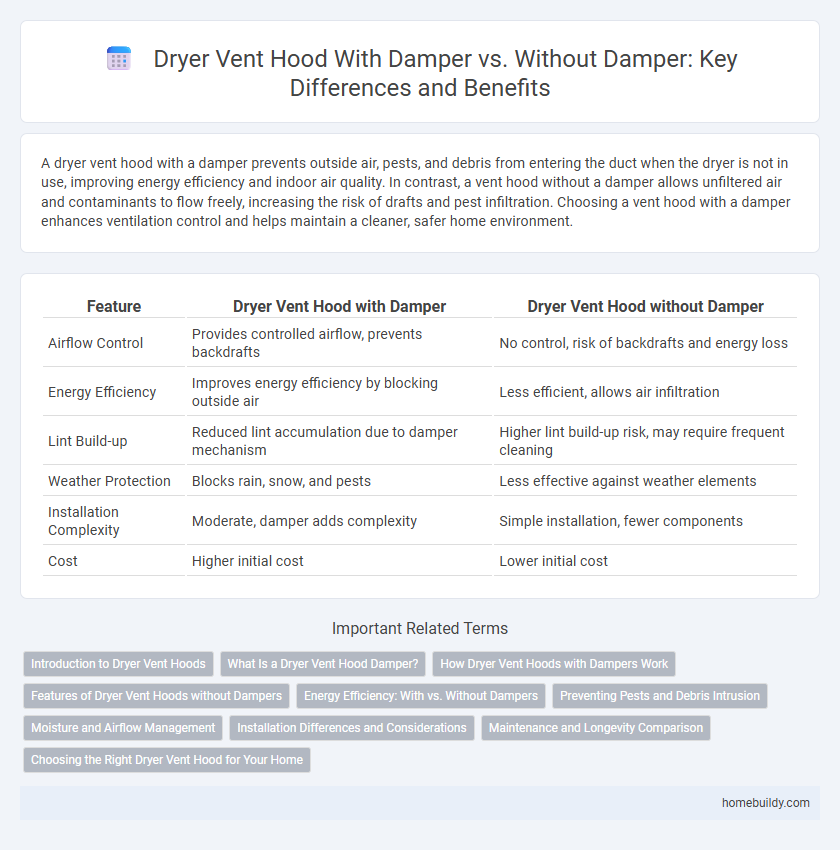A dryer vent hood with a damper prevents outside air, pests, and debris from entering the duct when the dryer is not in use, improving energy efficiency and indoor air quality. In contrast, a vent hood without a damper allows unfiltered air and contaminants to flow freely, increasing the risk of drafts and pest infiltration. Choosing a vent hood with a damper enhances ventilation control and helps maintain a cleaner, safer home environment.
Table of Comparison
| Feature | Dryer Vent Hood with Damper | Dryer Vent Hood without Damper |
|---|---|---|
| Airflow Control | Provides controlled airflow, prevents backdrafts | No control, risk of backdrafts and energy loss |
| Energy Efficiency | Improves energy efficiency by blocking outside air | Less efficient, allows air infiltration |
| Lint Build-up | Reduced lint accumulation due to damper mechanism | Higher lint build-up risk, may require frequent cleaning |
| Weather Protection | Blocks rain, snow, and pests | Less effective against weather elements |
| Installation Complexity | Moderate, damper adds complexity | Simple installation, fewer components |
| Cost | Higher initial cost | Lower initial cost |
Introduction to Dryer Vent Hoods
Dryer vent hoods with dampers feature a built-in flap that prevents outside air, pests, and debris from entering the vent system, improving energy efficiency and indoor air quality. In contrast, vent hoods without dampers lack this sealing mechanism, which can lead to increased energy loss and potential blockage issues. Choosing the right dryer vent hood impacts dryer performance, home safety, and maintenance frequency.
What Is a Dryer Vent Hood Damper?
A dryer vent hood damper is a flap mechanism designed to prevent outdoor air, pests, and debris from entering the vent when the dryer is not in use. Dryer vent hoods with dampers improve energy efficiency by minimizing heat loss and reducing drafts, whereas those without dampers allow uncontrolled airflow, leading to potential moisture buildup and increased utility costs. Choosing a vent hood with a damper enhances indoor air quality and extends the lifespan of the dryer system by maintaining proper ventilation control.
How Dryer Vent Hoods with Dampers Work
Dryer vent hoods with dampers feature a spring-loaded flap that opens when the dryer is running and closes tightly when it is off, preventing outside air, pests, and debris from entering the ductwork. This mechanism improves energy efficiency by reducing heat loss and moisture intrusion, while maintaining proper ventilation for lint and exhaust gases to escape safely. In contrast, vent hoods without dampers lack this seal, potentially leading to increased drafts, higher utility costs, and more frequent maintenance due to accumulation of dirt and pests.
Features of Dryer Vent Hoods without Dampers
Dryer vent hoods without dampers feature a simple, unrestricted airflow design that prevents lint build-up and reduces airflow resistance, enabling efficient moisture expulsion. These vent hoods are typically easier to clean and maintain due to their straightforward structure, minimizing potential blockages compared to dampered versions. However, they lack the automatic flap mechanism to prevent external air, pests, or debris from entering when the dryer is off.
Energy Efficiency: With vs. Without Dampers
Dryer vent hoods with dampers significantly enhance energy efficiency by preventing cold air infiltration and reducing heat loss during dryer operation. Without dampers, backdrafts allow outside air to enter, increasing heating or cooling demands and energy consumption. Installing a damper-equipped vent hood ensures improved insulation and lower utility bills through better airflow control.
Preventing Pests and Debris Intrusion
Dryer vent hoods with dampers effectively prevent pests and debris from entering the duct system by automatically closing when the dryer is off, creating a barrier against insects, rodents, and leaves. In contrast, vent hoods without dampers remain open constantly, increasing the risk of blockages, pest infestations, and reduced dryer efficiency. Choosing a vent hood with a damper enhances both safety and maintenance by minimizing unwanted intrusions into the vent.
Moisture and Airflow Management
A dryer vent hood with a damper prevents moisture buildup by sealing off the vent when the dryer is not in use, which effectively reduces the risk of mold and mildew growth. This damper mechanism also enhances airflow management by allowing air to exit during operation and blocking outside elements such as pests and debris. In contrast, a vent hood without a damper may lead to increased moisture retention and compromised airflow, resulting in reduced dryer efficiency and potential damage to the vent system.
Installation Differences and Considerations
Dryer vent hoods with dampers require careful alignment to ensure the damper flap opens freely while preventing backdrafts, necessitating precise installation to maintain airflow efficiency and prevent lint buildup. In contrast, vent hoods without dampers offer simpler installation, as they lack moving parts, but may permit outdoor air, pests, and debris to enter when the dryer is off. Proper sealing and positioning are crucial in both cases to optimize ventilation and energy efficiency while minimizing maintenance needs.
Maintenance and Longevity Comparison
Dryer vent hoods with dampers reduce the infiltration of outdoor debris, pests, and air into the vent system, lowering the frequency of cleaning and extending the lifespan of the dryer components. Hoods without dampers allow constant airflow that can introduce lint buildup and environmental contaminants, leading to more frequent maintenance and potential vent damage. Using a vent hood with a damper improves system efficiency and durability by minimizing exposure to harmful elements and reducing wear on the dryer vent.
Choosing the Right Dryer Vent Hood for Your Home
Choosing the right dryer vent hood involves understanding the benefits of models with and without dampers. Dryer vent hoods with dampers help prevent cold air, pests, and debris from entering the home by automatically closing when the dryer is off, improving energy efficiency and indoor air quality. In contrast, vent hoods without dampers may offer simpler installation but lack the protective barrier, making them less effective for maintaining optimal ventilation and home cleanliness.
Dryer vent hood with damper vs without damper Infographic

 homebuildy.com
homebuildy.com